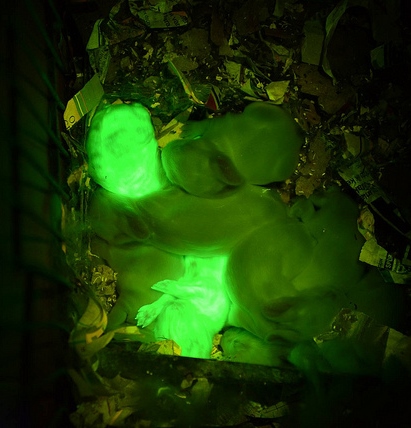Glow-in-the-Dark Rabbits
In normal light, the eight rabbits all look the same—white, cute, and begging to be squeezed. But switch to black light, and two stand out by brightly glowing green.

The rabbits were born last month at the University of Istanbul as part of collaboration between universities in Turkey and Hawaii. Sea jelly genes engineered into the bunnies’ genomes bestowed them with their luminous abilities (you can see more of the rabbits in this video).
The glowing rabbits are certainly not the first transgenic animals to light the night—researchers have already shown off glowing dogs, monkeys, cats, and many other species, including rabbits (see “Glowing Monkeys Inherit Jellyfish Genes” and “Fluorescent Cats to Help Fight AIDS”). The point of the flashy genetic engineering is not to give pet store owners a new product to hawk, but rather to confirm that the techniques researchers use to transfer genes into a genome are working. And in many cases, the greater goal is to develop new ways to study or treat disease.
As reported by The Guardian, the ultimate goal of the Turkish and Hawaiian collaboration is to refine techniques that could one day lead to animals capable of producing medicines in their milk. As Stefan Moisyadi, a University of Hawaii researcher involved in the project told The Guardian:
“The final goal is to develop animals … to produce beneficial molecules in their milk that can be cheaply extracted, especially in countries that cannot afford big pharma plants that make drugs, that usually cost $1bn to build, and be able to produce their own protein-based medication in animals.”
Other groups have already seen some success with this idea, and in 2009, the FDA approved a drug that is purified from the milk of a transgenic goat (see “FDA Approves First ‘Pharm’ Animals”). In a TV news interview, Moisyadi also mentions the potential for biologic drugs, such as replacement blood-clotting enzymes for people with hemophilia, to be produced more cheaply in transgenic animals than they are today.
Another cool idea in this space is to develop transgenic goats to produce malaria vaccine in their milk. Last year, researchers at Texas A&M University reported that they had indeed produced such a goat; the question remained whether her daughters would also be capable of making the life-saving medication. If proven successful and safe, the idea would be to take the goat’s offspring (or other goats like her) to developing countries with malaria outbreaks as a hardy source of vaccine.
Deep Dive
Biotechnology and health
How scientists traced a mysterious covid case back to six toilets
When wastewater surveillance turns into a hunt for a single infected individual, the ethics get tricky.
An AI-driven “factory of drugs” claims to have hit a big milestone
Insilico is part of a wave of companies betting on AI as the "next amazing revolution" in biology
The quest to legitimize longevity medicine
Longevity clinics offer a mix of services that largely cater to the wealthy. Now there’s a push to establish their work as a credible medical field.
There is a new most expensive drug in the world. Price tag: $4.25 million
But will the latest gene therapy suffer the curse of the costliest drug?
Stay connected
Get the latest updates from
MIT Technology Review
Discover special offers, top stories, upcoming events, and more.